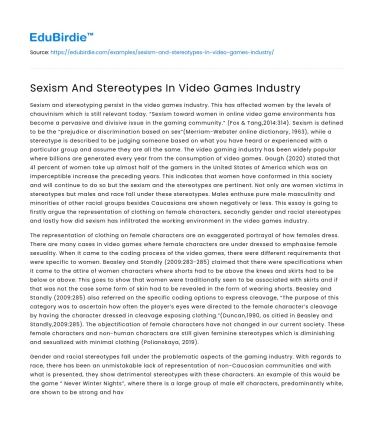Sexism and stereotyping persist in the video games industry. This has affected women by the levels of chauvinism which is still relevant today. “Sexism toward women in online video game environments has become a pervasive and divisive issue in the gaming community.” (Fox & Tang,2014:314). Sexism is defined to be the “prejudice or discrimination based on sex”(Merriam-Webster online dictionary, 1963), while a stereotype is described to be judging someone based on what you have heard or experienced with a particular group and assume they are all the same. The video gaming industry has been widely popular where billions are generated every year from the consumption of video games. Gough (2020) stated that 41 percent of women take up almost half of the gamers in the United States of America which was an imperceptible increase the preceding years. This indicates that women have conformed in this society and will continue to do so but the sexism and the stereotypes are pertinent. Not only are women victims in stereotypes but males and race fall under these stereotypes. Males enthuse pure male masculinity and minorities of other racial groups besides Caucasians are shown negatively or less. This essay is going to firstly argue the representation of clothing on female characters, secondly gender and racial stereotypes and lastly how did sexism has infiltrated the working environment in the video games industry.
The representation of clothing on female characters are an exaggerated portrayal of how females dress. There are many cases in video games where female characters are under dressed to emphasise female sexuality. When it came to the coding process of the video games, there were different requirements that were specific to women. Beasley and Standly (2009:283-285) claimed that there were specifications when it came to the attire of women characters where shorts had to be above the knees and skirts had to be below or above. This goes to show that women were traditionally seen to be associated with skirts and if that was not the case some form of skin had to be revealed in the form of wearing shorts. Beasley and Standly (2009:285) also referred on the specific coding options to express cleavage, “The purpose of this category was to ascertain how often the player’s eyes were directed to the female character’s cleavage by having the character dressed in cleavage exposing clothing.”(Duncan,1990, as citied in Beasley and Standly,2009:285). The objectification of female characters have not changed in our current society. These female characters and non-human characters are still given feminine stereotypes which is diminishing and sexualized with minimal clothing (Polianskaya, 2019).
Save your time!
We can take care of your essay
- Proper editing and formatting
- Free revision, title page, and bibliography
- Flexible prices and money-back guarantee
Gender and racial stereotypes fall under the problematic aspects of the gaming industry. With regards to race, there has been an unmistakable lack of representation of non-Caucasian communities and with what is presented, they show detrimental stereotypes with these characters. An example of this would be the game “ Never Winter Nights”, where there is a large group of male elf characters, predominantly white, are shown to be strong and have perfectly point ears while the one black male elf character appears to be weak, with a larger nose and circular elf ears( Peck, Ketchum and Embrick, 2011: 216). This has shown the injustice of the portrayal of a black character stigmatising the racial issues that happen. As discussed in the previous paragraph on how woman are shown to be overly sexualized, men are shown to be fearless and well built. In a group of 45 male characters, one third of the group exhibits the stereotypical antagonistic masculinity to help portray dominance because it is shown to be the only word used to describe males (Shoemaker and College, 2014). Gender and racial stereotypes have become the main building block of character development in games. Although we have become a socially aware society the stigma of race and gender is still relative when it comes to the harmful portrayal of minorities and glorified portrayals of the majority.
Sexism has infiltrated the working environment in the video games industry due to the disparity of females and males. “In 2019, 71 percent of responding developers where men, while 24 percent were women,” (Gough, 2020). A survey by Entertainment Software Association verifies that men and women are equally more likely to play video games (Kasumovic and Kuzenkoff, 2015). Although there is a consensus that women and men play video games there seems to be the ideology whereby video games are more associated with men. A couple of years ago women tweeted about sexual harassment and assault in a predominately male working environment (Jenson, 2013:74). A tweet disputing the claims of what women, “Women are too sensitive and self-absorbed to deal with criticism, its good they don’t design video games,” highlights on what some men think (Jenson,2013:74). This goes to shows that a predominately male work force shows no respect to women and their skills they have to offer. Women must constantly deal with public scrutiny especially if they are in an environment where they are inferior.






 Stuck on your essay?
Stuck on your essay?

